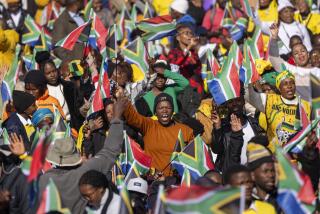Violence Is Its Own Worst Enemy : South Africa: Defiant non-cooperation, not armed struggle, has fueled the battle against apartheid. The ANC should renounce its campaign.
- Share via
As a military effort, the African National Congress’ campaign of armed struggle against South Africa’s apartheid government has been a disastrous failure.
Certainly, the violence has raised the costs for the white minority of not coming to terms with the ANC and the black majority. It has contributed to the perception among whites that things cannot go on as they are.
At the cost of thousands of black lives, however, not one inch of South African soil has been gained.
The campaign, launched in the early 1960s, led within months to the imprisonment of the leaders of the black nationalist movement--not for a few years but for more than a generation. The movement was decapitated and deprived of the guiding talents of such men as Nelson Mandela and Walter Sisulu. The white government seized on incidents of sabotage and violence to impose repressive laws that have stymied black protest ever since. The center of gravity of white politics moved even further to the right as the violence exacerbated the already exaggerated fears of the whites. The violent struggle brought new leaders to the fore of the black movement, military commanders far less inclined to lay down their arms to negotiate. The country--both whites and blacks--moved further from the vision of one day living in peace, side by side in the same nation.
If not the armed struggle, what then has produced the momentum toward reform? Two factors primarily. The first is that the black people of South Africa, for economic as well as political reasons, simply refused to comply with the white government’s vision of separate peoples living separately. Black workers streamed into the cities and brought their families with them. They built their own squatter towns. They ignored the pass laws, the influx control laws and the Group Areas Act. Some prospered and entered a growing black middle class. They refused to stay down. Progress was not granted by the whites; it has been taken by the blacks. Persistent, defiant non-cooperation has been the dominant method of resistance.
The second factor bringing about a change of mind among the white leadership is international pressure: financial sanctions, sports boycotts and the like. The outrage that produced the sanctions came more than anything else from the images of police brutally breaking up peaceful funeral marches and of unarmed black youths being whipped by white soldiers. When violence meets nonviolence, it is easy to tell who the good guys are. If anything, the armed struggle--with its occasional bombings of restaurants and bars--confused the moral clarity of the campaign against apartheid and defused international pressure.
All this makes one wonder what might have been achieved if the ANC had taken the surely heroic step of pursuing a purely nonviolent campaign in the face of South African repression. With its leadership talents and the will of the black people of South Africa, might a nonviolent ANC have induced the government to come to the negotiating table 5, 10, perhaps even 15 years ago?
Certainly this analysis suggests that, at little cost in effectiveness, the ANC could now renounce or suspend the armed struggle. And the rewards would be great. The unfortunate reality in South Africa is that power is still very much in white hands. To get to a truly nonracial democracy, a lot of white minds--and hearts--still need to be changed. Nothing the ANC could do would be as persuasive as ending the armed struggle. Nothing on the ANC’s part would contribute more to a favorable climate for serious constitutional negotiations. Those who argue that it is necessary to keep the pressure on the white government are correct, but that pressure will be more effective in the form of sustained nonviolent demonstrations and civil disobedience.
There is a broader lesson here for all those in today’s world concerned with social change. Where the many are unjustly treated by the powerful few, the temptation is to meet violence with violence. Yet, as Gandhi used to like to say, “An eye for an eye and we all go blind.” The most effective strategy is not to challenge the few in the arena of violence where they are strong, but in the arena of nonviolent struggle where the many can collectively exert their strength. As recent events in South Africa illustrate, in a match between violence and nonviolence, nonviolence may ultimately prove the victor.
More to Read
Sign up for Essential California
The most important California stories and recommendations in your inbox every morning.
You may occasionally receive promotional content from the Los Angeles Times.












